11.初中英语教师面试:语法课《情态动词教学》全英文教案及试讲逐字稿
- 格式:docx
- 大小:164.40 KB
- 文档页数:5
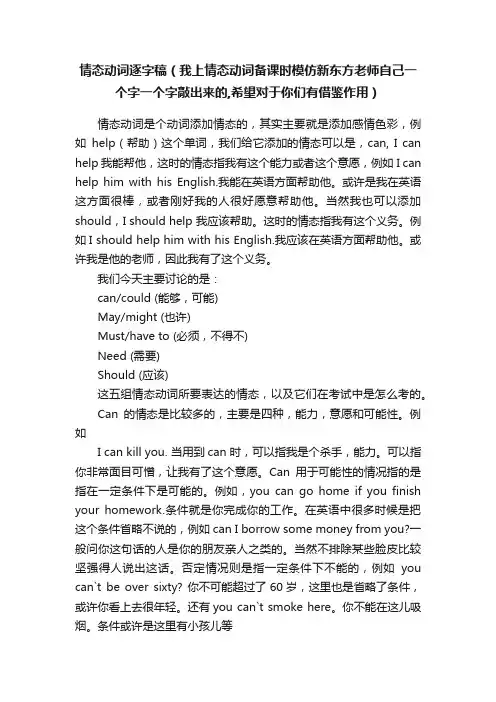
情态动词逐字稿(我上情态动词备课时模仿新东方老师自己一个字一个字敲出来的,希望对于你们有借鉴作用)情态动词是个动词添加情态的,其实主要就是添加感情色彩,例如help(帮助)这个单词,我们给它添加的情态可以是,can, I can help 我能帮他,这时的情态指我有这个能力或者这个意愿,例如I can help him with his English.我能在英语方面帮助他。
或许是我在英语这方面很棒,或者刚好我的人很好愿意帮助他。
当然我也可以添加should,I should help 我应该帮助。
这时的情态指我有这个义务。
例如I should help him with his English.我应该在英语方面帮助他。
或许我是他的老师,因此我有了这个义务。
我们今天主要讨论的是:can/could (能够,可能)May/might (也许)Must/have to (必须,不得不)Need (需要)Should (应该)这五组情态动词所要表达的情态,以及它们在考试中是怎么考的。
Can的情态是比较多的,主要是四种,能力,意愿和可能性。
例如I can kill you. 当用到can 时,可以指我是个杀手,能力。
可以指你非常面目可憎,让我有了这个意愿。
Can用于可能性的情况指的是指在一定条件下是可能的。
例如,you can go home if you finish your homework.条件就是你完成你的工作。
在英语中很多时候是把这个条件省略不说的,例如can I borrow some money from you?一般问你这句话的人是你的朋友亲人之类的。
当然不排除某些脸皮比较坚强得人说出这话。
否定情况则是指一定条件下不能的,例如you can`t be over sixty? 你不可能超过了60岁,这里也是省略了条件,或许你看上去很年轻。
还有you can`t smoke here。
你不能在这儿吸烟。
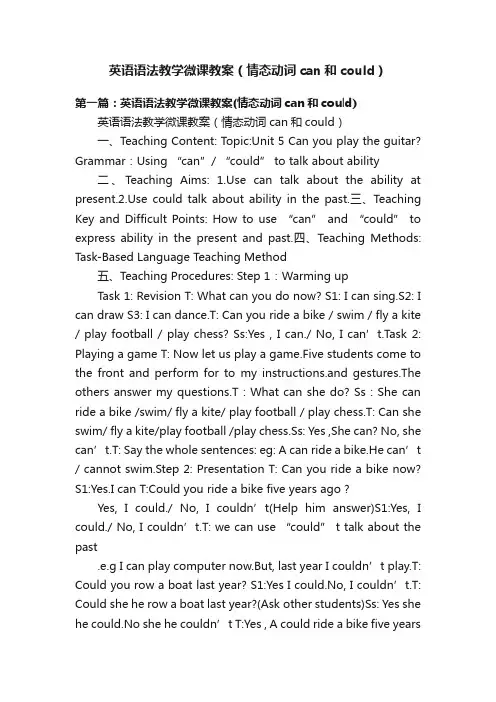
英语语法教学微课教案(情态动词can和could)第一篇:英语语法教学微课教案(情态动词can和could) 英语语法教学微课教案(情态动词can和could)一、Teaching Content: Topic:Unit 5 Can you play the guitar? Grammar:Using “can”/ “could” to talk about ability二、Teaching Aims: e can talk about the ability at e could talk about ability in the past.三、Teaching Key and Difficult Points: How to use “can” and “could” to express ability in the present and past.四、Teaching Methods: Task-Based Language Teaching Method五、Teaching Procedures: Step 1:Warming upTask 1: Revision T: What can you do now? S1: I can sing.S2: I can draw S3: I can dance.T: Can you ride a bike / swim / fly a kite / play football / play chess? Ss:Yes , I can./ No, I can’t.Task 2: Playing a game T: Now let us play a game.Five students come to the front and perform for to my instructions.and gestures.The others answer my questions.T : What can she do? Ss : She can ride a bike /swim/ fly a kite/ play football / play chess.T: Can she swim/ fly a kite/play football /play chess.Ss: Yes ,She can? No, she can’t.T: Say the whole sentences: eg: A can ride a bike.He can’t / cannot swim.Step 2: Presentation T: Can you ride a bike now? S1:Yes.I can T:Could you ride a bike five years ago ?Yes, I could./ No, I couldn’t(Help him answer)S1:Yes, I could./ No, I couldn’t.T: we can use “could” t talk about the past.e.g I can play computer now.But, last year I couldn’t play.T: Could you row a boat last year? S1:Yes I could.No, I couldn’t.T: Could she he row a boat last year?(Ask other students)Ss: Yes she he could.No she he couldn’t T:Yes , A could ride a bike five yearsago.He couldn’t swim five years ago.the class according(Teach the students to say the whole sentences): A could ride a bike five ye ars ago.He couldn’t swim five years ago.)(Ask other students in the same ways)Step 3: Practice :work in pairs T: Ask your partner more questions eg: Could he / she …?(Yes, he / she could./ No, he / she couldn’t.)...Step 4: Production Task 3: Explanation T: Let’s work out the rule.① 肯定句式: can could② 否定句式: can’t couldn’t③ 疑问句式: Can …?Could …?T: We can use “am(is , are)able to “ instead of “can”,and “was(were)able to “ instead of “could“.eg.①Mike can sing more than 20 English songs.Mike is able to …②She c ould speak English when she was four.She was able to…T: Please give more examples.to practice them.Step 5: Summary T:In this class, we have learnt the use of can and could about talking about abilities.Who knows the differences between “can” and “could” S tep 6: Homework Finish off the practice on the workbooks ,Fill in the blank with can/could第二篇:英语人教版八年级下册情态动词can和could微课教学设计初中英语语法教学微课教学设计(情态动词can和could)教学思路: 本节课我教的是情态动词can和could作“能力”解时的区别。
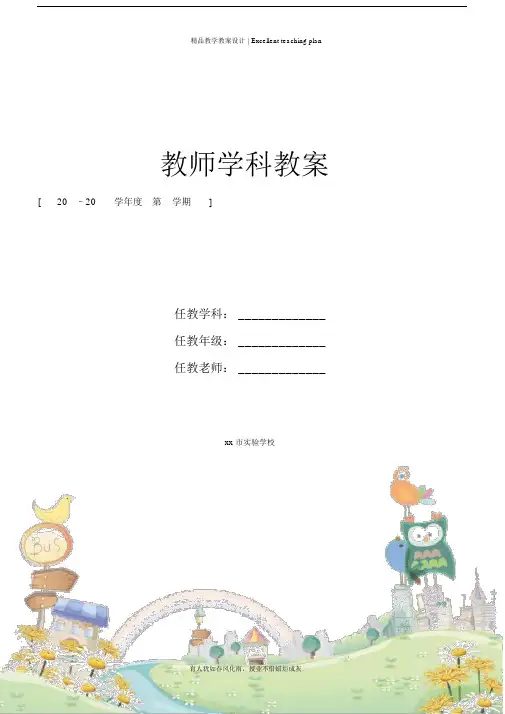
精品教学教案设计| Excellent teaching plan教师学科教案[ 20–20学年度第__学期]任教学科: _____________任教年级: _____________任教老师: _____________xx市实验学校精品教学教案设计| Excellent teaching plan 初中英语语法教学微课教案(情态动词can 和 could )汤山中学彭胜芳教学思路 :本节课我教的是情态动词can 和 could 作“能力”解时的区别。
这节课我打算通过复习以前学过的情态动词can 的用法,以及通过做游戏,让学生在轻松愉快的氛围中掌握can 的用法,以及了解can 和 could 的区别。
一、 Teaching Content:Unit 3Can you play the guitar?Grammar:Using “can”/“could” to talk about ability二、 Teaching Aims:e can talk about the ability at present.e could talk about ability in the past.三、 Teaching Key and Difficult Points:Howto use “can”and “could ”to express ability in the present and past.四、 Teaching Methods:Task-Based Language Teaching Method五、 Teaching Procedures:Step 1 :Warming upTask 1: RevisionT: What can you do now?精品教学教案设计| Excellent teaching planS1: I can sing.S2: I can drawS3: I can dance.T:Can you ride a bike / swim / fly a kite / play football/play chess?Ss:Yes , I can. / No, I can’t.Task 2: Playing a gameT: Now let us play a game. Five students come to the front and perform for the class according to my instructions.and gestures.The others answer my questions.T : What can she do?Ss : She can ride a bike /swim/ fly a kite/ play football/ play chess .T: Can she swim/ fly a kite/play football /play chess.Ss: Yes ,She can? No, she can’t.T: Say the whole sentences:eg: A can ride a bike.He can ’t / cannot swim.Step 2: PresentationT: Can you ride a bike now?S1:Yes. I canT:-Could you ride a bike five years ago ?-Yes, I could./ No, I couldn’t( Help him answer)S1:Yes, I could./ No, I couldn’t.T: we can use“could” t talk about the paste.g I can play computer now .But, last year I couldn’tplay.T: Could you row a boat last year?S1:Yes I could . No, I couldn’t.T: Could she he row a boat last year?( Ask other students)Ss: Yes she he could . No she he couldn’tT:Yes , A could ride a bike five years ago.He couldn ’t swim five years ago.(Teach the students to say the whole sentences):A could ride a bike five years ago.He couldn ’t swim five years ago.)(Ask other students in the same ways)Step 3:Practice :work in pairsT: Ask your partner more questionseg: Could he / she⋯?(Yes, he / she could. / No, he / she couldn’t.) ...Step4: ProductionTask 3: ExplanationT: Let ’s work out the rule.①肯定句式 : can\ could②否定句式 : can ’t\ couldn’t③疑句式 : Can⋯?\Could⋯?T: Wecan use “am(is , are) able to “ instead of “can”,and “was (were) able to“ instead of“could“.eg. ①Mike can sing more than 20 English songs.Mike is able to⋯②S he could speak English when she was four.She was able to⋯T:Please give more examples.to practice them.Step 5: SummaryT:In this class, we have learnt the use of can and could about talking about abilities .Who knows the differences between “can” and“could ”Step 6:HomeworkFinish off the practice on the workbooks ,Fill in the blank with can/could。
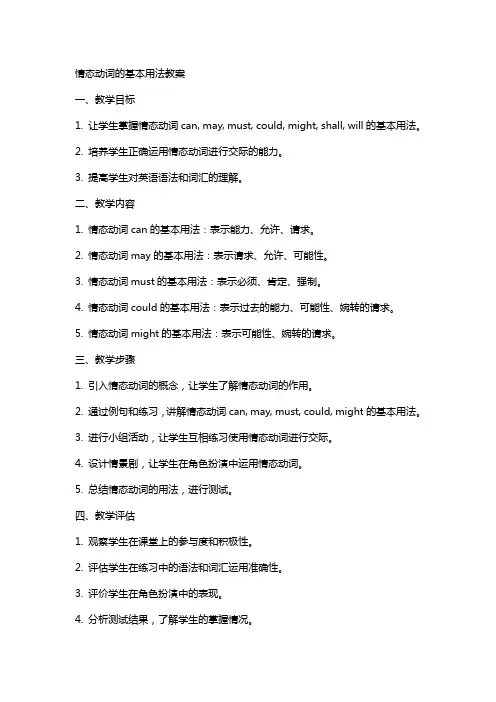
情态动词的基本用法教案一、教学目标1. 让学生掌握情态动词can, may, must, could, might, shall, will的基本用法。
2. 培养学生正确运用情态动词进行交际的能力。
3. 提高学生对英语语法和词汇的理解。
二、教学内容1. 情态动词can的基本用法:表示能力、允许、请求。
2. 情态动词may的基本用法:表示请求、允许、可能性。
3. 情态动词must的基本用法:表示必须、肯定、强制。
4. 情态动词could的基本用法:表示过去的能力、可能性、婉转的请求。
5. 情态动词might的基本用法:表示可能性、婉转的请求。
三、教学步骤1. 引入情态动词的概念,让学生了解情态动词的作用。
2. 通过例句和练习,讲解情态动词can, may, must, could, might的基本用法。
3. 进行小组活动,让学生互相练习使用情态动词进行交际。
4. 设计情景剧,让学生在角色扮演中运用情态动词。
5. 总结情态动词的用法,进行测试。
四、教学评估1. 观察学生在课堂上的参与度和积极性。
2. 评估学生在练习中的语法和词汇运用准确性。
3. 评价学生在角色扮演中的表现。
4. 分析测试结果,了解学生的掌握情况。
五、教学资源1. 情态动词的PPT演示。
2. 情态动词的例句和练习题。
3. 情景剧的角色扮演材料。
4. 测试题。
5. 录音机或音响设备,用于播放情景剧的音频。
六、教学扩展1. 引入其他情态动词如shall和will,解释它们在不同语境中的用法。
2. 通过例句和练习,让学生掌握shall和will的区别。
3. 进行小组活动,让学生在实际语境中运用shall和will。
七、课堂互动1. 设计问答环节,让学生用情态动词回答问题。
2. 进行情态动词的接龙游戏,激发学生的学习兴趣。
3. 组织学生进行情态动词的知识竞赛,增强学生的团队合作精神。
八、家庭作业1. 布置相关的练习题,让学生巩固情态动词的用法。
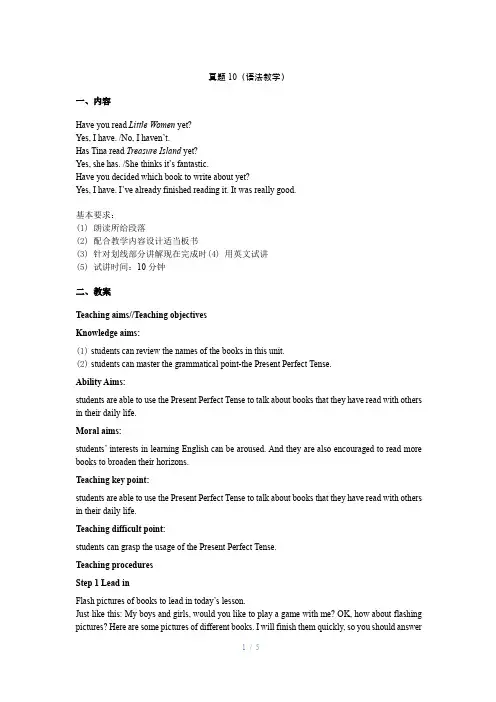
真题10(语法教学)一、内容Have you read Little Women yet?Yes, I have. /No, I haven’t.Has Tina read Treasure Island yet?Yes, she has. /She thinks it’s fantastic.Have you decided which book to write about yet?Yes, I have. I’ve already finished reading it. It was really good.基本要求:(1)朗读所给段落(2)配合教学内容设计适当板书(3)针对划线部分讲解现在完成时(4)用英文试讲(5)试讲时间:10分钟二、教案Teaching aims//Teaching objectivesKnowledge aims:(1) students can review the names of the books in this unit.(2) students can master the grammatical point-the Present Perfect Tense.Ability Aims:students are able to use the Present Perfect Tense to talk about books that they have read with others in their daily life.Moral aims:students’ interests in learning English can be aroused. And they are also encouraged to read more books to broaden their horizons.Teaching key point:students are able to use the Present Perfect Tense to talk about books that they have read with others in their daily life.Teaching difficult point:students can grasp the usage of the Present Perfect Tense.Teaching proceduresStep 1 Lead inFlash pictures of books to lead in today’s lesson.Just like this: My boys and girls, would you like to play a game with me? OK, how about flashing pictures? Here are some pictures of different books. I will finish them quickly, so you should answerthem quickly. Are you clear? Readygo! Alice in Wonderland. Oliver Twist. Little Women. Treasure Island. Wow, amazing! You all did such a wonderful job!Step 2 PresentationShow the sentences on the PowerPoint and ask students to find out the common part. Just like this: While you are reading, did you find the common part of these words?Bobby please, you mean the tense is the same. Clever, you found it. What tense is it? Yes, the tense is called"the Present Perfect Tense". (板书)So, if the things happened in the past and have an impact on the present, we should use the Present Perfect Tense.Then explain the rules and conclude the sentence pattern. Boys and girls, let’s conclude the rule together. If the things happened in the past and have an impact on the present, we should use the Present Perfect Tense. And the sentence pattern is"Have/Has sb. done sth.? Yes, sb. have/has. No, sb. haven’t/hasn’t."Brilliant. You did such a good job!Step 3 PracticeTask l: students try to fill in the blanks with the correct forms of words in brackets.-Would you like something to eat?No, thanks. I___ (drink) some tea.-___ you___ (find) the key?No, not yet.-Is your sister going to the movies with us tonight?No, she has____ (already see) it.(The answers are: have drunk, Have found, already seen)Task 2: Please according to the pictures on the PowerPoint, work in pairs to complete the short passage about Sally.Sally loves reading. She ___ already ___ many different kinds of books. For example, she ___ Harry Potter. She thinks it is very interesting. She even ___ already ___ the movies...(The answers are: has read, has read, has seen)Step 4 ProductionFour students as a group to have a discussion about what their group members have read. Then make a report.Step 5 SummaryAsk students to summarize what they have learned today and the teacher gives supplement timely. Students are encouraged to read more books to broaden their horizons.Step 6 HomeworkStudents are encouraged to interview their friends about the books they have read. And tomorrow show the results.Blackboardthe Present Perfect Tense-Have/Has sb. done sth.?-Yes, sb. have/has. No, sb. haven’t/hasn’t.三、试讲稿Good morning, dear judges. I am No. 1 candidate. My topic is books. Now I will begin my class. Good morning, boys and girls, how are you today? Fine! Good! Great! I am great, too. Thanks for your asking. Are you ready for our English travel? OK, here we go.My boys and girls, would you like to play a game with me? OK, how about flashing pictures? Here are some pictures of different books. I will finish them quickly, so you should answer them quickly. Are you clear? Ready go! Alice in Wonderland. Oliver Twist. Little Women. Treasure Island. Wow, amazing! You all did a wonderful job!My boys and girls, have you read Little Women yet? Amy please, yes, I have. Good answer. Mike please, no, I haven’t. What a pity! It’s a good book. I hope you can read it next time. My boys and girls, we have learned some sentences like this in this unit. Do you remember? No? That’s okay. Look, here are some on the PowerPoint. Let’s read them together. While you are reading, you should pay attention to the common part of the sentences. OK? Here we go. "Have you read Little Women yet? Yes, I have. /No, I haven’t. Has Tina read Treasure Island yet? Yes, she has. /She thinks it’s fantastic. Have you decided which book to write about yet? Yes, I have. I’ve already finished reading it. It was really good."(此处可朗读所给段落)Good reading. While you are reading, did you find the common part of these words? Bobby please, you mean the tense is the same. Clever, you found it. What tense is it? Yes, the tense is called"the Present Perfect Tense".(板书)So, if the things happened in the past and have an impact on the present, we should use the Present Perfect Tense. Are you clear? Good. What else did you find? Nick please, they begin with"have"or"has". Well done. So, everybody, can you try to conclude the sentence patterns? Lisa please, the sentence pattern is"Has sb. did sth.? Yes, sb. has. / No, sb. hasn’t."Wow, you did very well. But we need to be specific. Actually, the sentence pattern is"Has sb. done sth.? Yes, sb. has. No, sb. hasn’t. ". It’s"done", not"did". That means the verbs should become past participles instead of past tense. Understand? What about the second sentence pattern? Clever,"Has sb. done sth.? Yes, sb. has. /No, sb. hasn’t."Boys and girls, let’s conclude the rule together. If the things happened in the past and have an impact on the present, we should use the Present Perfect Tense. And the sentence pattern is"Have/Has sb. done sth.? Yes, sb. have/has. No, sb. haven’t/hasn’t."(板书句型)Brilliant. You did such a good job! So, why don’t do some exercises to test yourself? Look, here are two tasks for you. Task 1: Please fill in the blanks with the correct forms of the words in brackets. 3 minutes for you.-Would you like something to eat?No, thanks. I ___ (drink) some tea._you ___ (find) the key?No, not yet.-Is your sister going to the movies with us tonight?No, she has ___ (already see) it.Time’s up. What’s your answer? Well, most of the students in this line raised their hands. So, this line please, answer it one by one. The first one,"Would you like something to eat? No, thanks. I..."Yes, I have drunk some tea. Good answer. The second blank should be... Yes,"Have found",nice work. What about the third one? The answer is"already seen",very well. OK, let’s move on to the second task. Class, do you want to know something about our friends Sally? Please according to the pictures on the PowerPoint, work in pairs to complete the short passage about Sally. 5 minutes for you. Let’s get started. //Time’s up. Let’s check the answers together."Sally loves reading. She has already read many different kinds of books. For example, she has read Harry Potter. She thinks it is very interesting. She even has already seen the movies..."Did you get the right answers? Wow, so many of you get the right answers. Big hands for yourselves. Everybody, do you want to know more about your group members? 4 students as a group to do a survey. The questions are:Have you read...yet?What do you think of...?Then show your results to us. You can introduce like this: In our group, Nick has read Little Women. He thinks it is meaningful... Are you clear? 8 minutes for you. Start. // Time is up. Who wants to come to the stage to show your dialogue? Wow, so many of you raised your hands. Why not play the game"Hot potato"? Look, this is the potato, it’s so hot that you have to pass it one by one quickly. And when I say stop, the one who is holding the potato will have the chance. Clear? Here we go. Stop. Maria, how lucky you are! Please come to the stage. You can start."In our group, Nancy has read Little Women. She thinks it is educational. Tim and Emily have read Harry Potter. They both think it is very interesting..."(复述)//What a good report! Please go back to your seat. How time flies. Who can summarize what we have learned today? The brave boy, please. You said we have learned the grammar-the Present Perfect Tense. Good job, you listened very carefully. Everybody, after this class, I hope you guys can read more books to broaden your horizons. OK? Here comes your homework, please interview your friends about the books they have read. Tomorrow I will ask you to show it, OK? So much for today. See you tomorrow.That’s all. Thank you. May I clean the blackboard?四、答辩1. Please talk about the differences between the present perfect tense and the simple past tense. 答:Now I am going to talk about the differences between the present perfect tense and the simple past tense.First of all, their basic forms are different. The basic form of the simple past tense is"sb. did sth.",but as you can see, the basic form of the present perfect tense is"sb. have/has done sth.". The biggest difference is the verb. One is "did",but the other is"have/has done". Besides, when to use them is different. If the things happened in the past and they have no impact on the present, we should use the simple past tense. If the things happened in the past, and they have an impact on the present, we should use the present perfect tense.I think these are the differences between the present perfect and the simple past tense. That’s all, thank you.2. Please talk about the procedure of the grammar class.答:Now I am going to talk about the procedure of the grammar class.(1) Lead in. I will play a game"Flash pictures"to review the name of books and lead in today’s lesson.(2) Presentation. I will ask students to read the sentences on the PowerPoint. When they are reading,I will ask them to find the common part of these sentences. Later I will explain the rules of the Present Perfect Tense and try to conclude the sentence patterns.(3)Practice. There will be two tasks for students. Task 1 is filling the blanks and task 2 is completing the short passage about Sally.(4) Consolidation. I will ask students to do a survey about the books that their group members have read.(5) Summary and Homework. Students summarize first and I will give supplement timely. Students are encouraged to read more books to broaden their horizons. The homework is to interview their friends about the books they have read.(6) Blackboard design. As you can see, this is my blackboard design.。
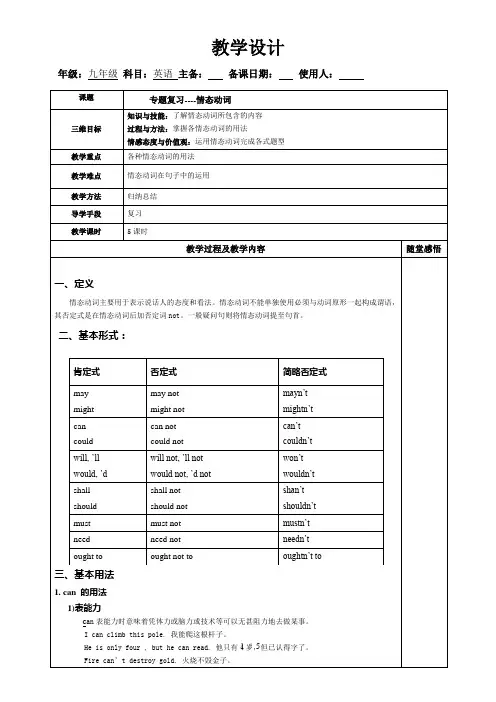
年级:九年级科目:英语主备:备课日期:使用人:had better do sth. / had better not do sth. (重点)You had better keep silent in class.四、易错点:(一)、can, may, must , need, should的提问与应答:(1). Can I go to the cinema tonight?Yes, you can./No, you can’t.(2). May I have a look at your photos?Yes, you may / can./No, you mustn’t / can’t.(3). Must I book a ticket for the concert right now?Yes, you must./No, you needn’t / don’t have to.(4). Need I water the flowers in the garden in the afternoon?Yes, you need / must./No, you mustn’t.(二)、表示判断: may / may not, must ( be ) / can’t ( be )(1). 判断语气坚定,有理有据(常摆出理由)①. 肯定判断( must )e.g. The light in the office is on. Our teacher must be still working.It must have rained last night, for the ground is wet and muddy.②. 否定判断(can’t / can not)注:不能用must not 或mustn’t 形式e.g. Mr. Green can’t be at home, for I met him at the street just now.This book can’t be Betty’s. She doesn’t like detective stories.(2). 判断语气不坚定,模棱两可,不确定,常附带有I’m not sure / I don’t know等句子。
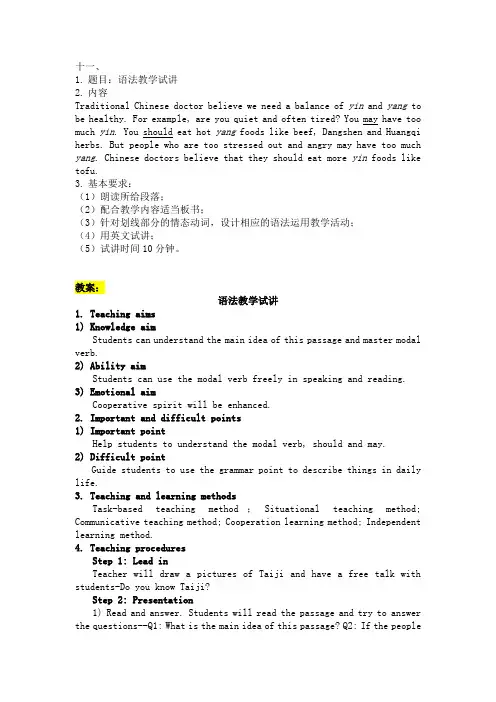
十一、1.题目:语法教学试讲2.内容Traditional Chinese doctor believe we need a balance of yin and yang to be healthy. For example, are you quiet and often tired? You may have too much yin.You should eat hot yang foods like beef, Dangshen and Huangqi herbs. But people who are too stressed out and angry may have too much yang. Chinese doctors believe that they should eat more yin foods like tofu.3.基本要求:(1)朗读所给段落;(2)配合教学内容适当板书;(3)针对划线部分的情态动词,设计相应的语法运用教学活动;(4)用英文试讲;(5)试讲时间10分钟。
教案:语法教学试讲1. Teaching aims1) Knowledge aimStudents can understand the main idea of this passage and master modal verb.2) Ability aimStudents can use the modal verb freely in speaking and reading. 3) Emotional aimCooperative spirit will be enhanced.2. Important and difficult points1) Important pointHelp students to understand the modal verb, should and may.2) Difficult pointGuide students to use the grammar point to describe things in daily life.3. Teaching and learning methodsTask-based teaching method;Situational teaching method; Communicative teaching method; Cooperation learning method; Independent learning method.4. Teaching proceduresStep 1: Lead inTeacher will draw a pictures of Taiji and have a free talk with students-Do you know Taiji?Step 2: Presentation1) Read and answer. Students will read the passage and try to answer the questions--Q1: What is the main idea of this passage? Q2: If the peoplewho are too stressed out and angry, what should they do?2) Conclude the grammar. Students will be guided to conclude the similar grammar structure-should ,may.......and share their ideas in groups. Then teacher will introduce the modal verb: may, should. And also, the negative forms-may not/should not…Step 3: Practice1) Translation game. Students will work in pairs and translate the sentences with each other by using the new grammar point.2) Fill in the blanks with may and should.Step 4: Production1)Group discussion and design. Students will talk about the balance of yin and yang, and show their opinions.2)Make a report by using the new grammar structure. Some students will be invited to show their reports to the whole class.Step 5: Summary and homework1) Some students will be guided to summarize what they have learned in this class.2) Search more information about yin and yang on the internet. Then write a short passage about it.5. Blackboard designYin: yangQuiet angryTired stressed outToufu beef、dangshen、huangqiYou may have too much yin. You should eat hot yang food.You may have too much yang. You should eat more yin food.试讲稿:语法教学GreetingGood morning, my dear students. How are you? Pretty good.Great? How about me? I'm great. Thanks for asking.Step 1: Lead inBefore our class, I want to show you a picture, Q: do you know this old man? He is a philosopher in the Spring and Autumn Period founder of Taoism ,his name is Laozi. The picture is very famous in the world, let’s say it together, Yes, it’s Taiji. Today we’ll learn something about this magic thing.Step 2: PresentationNow let’s read this passage and then find out the main idea.Traditional Chinese doctor believe we need a balance of yin and yang to be healthy. For example, are you quiet and often tired? You may have too much yin. You should eat hot yang foods like beef, Dangshen and Huangqi herbs. But people who are too stressed out and angry may have too much yang. Chinese doctors believe that they should eat more yin foods like tofu.Have you finished? Yes, who can write down your answers on the blackboard. you, please. Do you agree with her? Perfect! Thank you.1)You said that it is about yin and yang, right? During your first time reading, have you notice “may”, “should”? No? That’s all right. Let’s read this passage again to find out the answers. You can discuss with your partner. And then answer my question: if you are quiet and often tired, what should you do? One minute for you. OK, stop here. Have you found? Clearly, you should eat hot yang foods like beef, dangshen ang huangqi. Because you may have too much yin.2)We learned about verbs and nouns and so on, do you know what these two words are called? It’s maybe a little difficult. You can have discussion in groups. Ding dong, time is up! Which group wants to share your ideas? Group 2, please. Tom! You have no idea? You should look at your book carefully. Anything else? Tina. Very good. Sit down, please.Do you have different ideas? The two words are called modal verb. Wow, good job. How do you know that? You have previewed this lesson. You are a hard-working girl! Now everyone you should know that the first one is may/mei/, you use may to indicate that something will possibly happen or be true in the future, but you cannot be certain. The other one is should. And the negative form, may not and should not. I think everyone can read it very well. You use should when you are saying what would be the right thing to do or the right state for something to be in.Step 3: PracticeIt’s time for us to do some practice. I prepare a Translation game for you. You will work in pairs and translate the sentences with each other by using the new words. I will show some sentences of new words on the PPT. You should read these sentences and translate it. One two three, go! OK, stop here. You are so active. Let’s read it one by one group 1, you should read it loudly. Excellent. How about group 2. You may have two sentences. Group 3,you should be better. Now let’s read it together.So much for this exercise. Open your exercise book, let’s fill in blanks. 6 minutes for you. Finished? Who wants to share your answers? Jack, please. OK, Jack’s answer is right? No? Which one is not? Let’s help him to correct it. The answer should be “He may be very busy now.” Jack, pay attention to the meaning.Step 4: ProductionAt the beginning of the class, I prepare a picture for you. The circle is divided into two parts. And the Chinese doctor believe we need a balance of yin and yang to be healthy. So can you imagine how can we keep a balanced lifestyle? You can discuss with your partner. If you have any problem you can put you hands up. Five minutes for you. Then I will invite someone to show your opinion in front of class. Got it? Let’s begin. Three, two, one, stop! The girl in red, please. We should run every day. Thank you.Running may help us build up our bodies. Any volunteer? This boy, please. To keep you healthy, you should to eat less junk food and drink more water. You answer is perfect. Thanks, sit down.Then you can make a report about these healthy diet and show us one by one. Let’s start. Nina, can you show us your report? Great. Alice, do you want to try? Thank you. Everyone did a good job. I’m so happy that you all know so much healthy diet, but you should keep good living habits.Step 5: Summary and homeworkWell, how time flies! It’s nearly the end of this class. Who can help us to make a conclusion. What we have learned today? The boy in corner, please.Modal verb: should and may. Yes we have learnt modal verb, and how to give people advice by using the modal verbs.Of course, after class, you can search more information about yin and yang on the internet. Then write a short passage to describe your own advice.OK, so much for today, see you next time.5. Blackboard designYin: yangQuiet angryTired stressed outToufu beef、dangshen、huangqiYou may have too much yin. You should eat hot yang food.You may have too much yang. You should eat more yin food.。
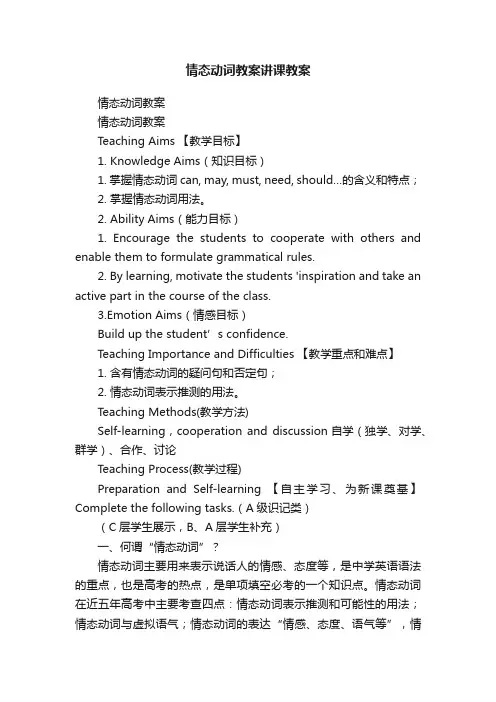
情态动词教案讲课教案情态动词教案情态动词教案Teaching Aims 【教学目标】1. Knowledge Aims(知识目标)1. 掌握情态动词can, may, must, need, should…的含义和特点;2. 掌握情态动词用法。
2. Ability Aims(能力目标)1. Encourage the students to cooperate with others and enable them to formulate grammatical rules.2. By learning, motivate the students 'inspiration and take an active part in the course of the class.3.Emotion Aims(情感目标)Build up the student’s confidence.Teaching Importance and Difficulties 【教学重点和难点】1. 含有情态动词的疑问句和否定句;2. 情态动词表示推测的用法。
Teaching Methods(教学方法)Self-learning,cooperation and discussion自学(独学、对学、群学)、合作、讨论Teaching Process(教学过程)Preparation and Self-learning 【自主学习、为新课奠基】Complete the following tasks.(A级识记类)(C层学生展示,B、A层学生补充)一、何谓“情态动词”?情态动词主要用来表示说话人的情感、态度等,是中学英语语法的重点,也是高考的热点,是单项填空必考的一个知识点。
情态动词在近五年高考中主要考查四点:情态动词表示推测和可能性的用法;情态动词与虚拟语气;情态动词的表达“情感、态度、语气等”,情态动词表示“必要性”等方面的用法。
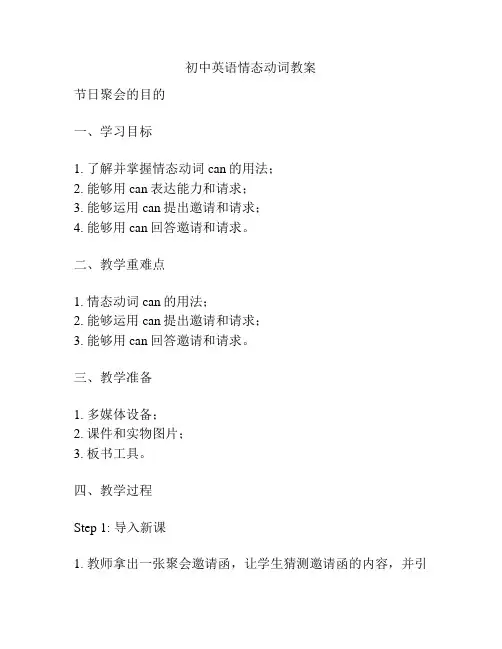
初中英语情态动词教案节日聚会的目的一、学习目标1. 了解并掌握情态动词can的用法;2. 能够用can表达能力和请求;3. 能够运用can提出邀请和请求;4. 能够用can回答邀请和请求。
二、教学重难点1. 情态动词can的用法;2. 能够运用can提出邀请和请求;3. 能够用can回答邀请和请求。
三、教学准备1. 多媒体设备;2. 课件和实物图片;3. 板书工具。
四、教学过程Step 1: 导入新课1. 教师拿出一张聚会邀请函,让学生猜测邀请函的内容,并引出Invitation(邀请)的概念。
2. 引出can的用法,例如:Teacher: Can you come to my party?Student: Yes, I can. / No, I can't.Teacher: Can you help me with my homework?Student: Yes, I can. / No, I can't.通过问题与回答的形式,让学生了解can的用法。
Step 2: 展示实物图片1. 教师展示一些实物图片,并向学生提出相关的邀请和请求,如:Teacher: Can you bring some drinks to the party?Student: Yes, I can. / No, I can't.通过实物图片的展示,让学生在情境中运用can。
2. 教师展示一张聚会的照片,向学生提问并引出更多的邀请和请求,如:Teacher: Can you help me decorate the room?Student: Yes, I can. / No, I can't.通过图片的展示,让学生在情境中运用can。
Step 3: 练习活动1. 教师出示课件上的几个情境,让学生组成小组,互相提出邀请和请求,并用can回答,并展示给全班。
2. 教师提问学生一些情境问题,并让学生运用can进行回答。
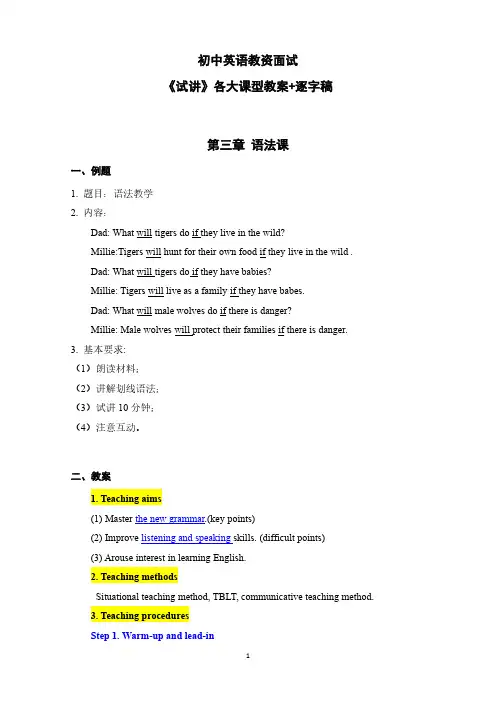
初中英语教资面试《试讲》各大课型教案+逐字稿第三章语法课一、例题1.题目:语法教学2.内容:Dad:What will tigers do if they live in the wild?Millie:Tigers will hunt for their own food if they live in the wild.Dad:What will tigers do if they have babies?Millie:Tigers will live as a family if they have babes.Dad:What will male wolves do if there is danger?Millie:Male wolves will protect their families if there is danger.3.基本要求:(1)朗读材料;(2)讲解划线语法;(3)试讲10分钟;(4)注意互动。
二、教案1.Teaching aims(1)Master the new grammar.(key points)(2)Improve listening and speaking skills.(difficult points)(3)Arouse interest in learning English.2.Teaching methodsSituational teaching method,TBLT,communicative teaching method.3.Teaching proceduresStep1.Warm-up and lead-in(1)Sing:<Monsters>.(2)Video:the documentary of BBC.(nature and animals on the earth;animals’behaviors)→Title:Tigers and wolvesStep2.Presentation(1)Find the main idea:What’s the conversation mainly about?(the life of tigers and wolves.)(2)Explain grammar knowledge:A.Show the sentences;B.Read and find similarities in groups.(The length of sentences is similar.)C.Conclude the grammar point:adverbial clause of condition.Step3.Practice(1)Fill in the blanks.(A.Tigers will hunt for their own food if they live in the wild.B.Tigers will live as a family if they have babes…)(2)Pass the ball.make a sentence with the grammar point.Step4.ProductionDiscussion:How about the behaviors of other animals?Step5.Summary and homework(1)Summary:adverbial clause of condition;we should protect nature and wild animals.(2)Homework:the adverbial clause of condition.4.Blackboard design三、逐字稿Step1.Warm-up and lead-inT:Class begins!Boys and girls,how are you today?Oh,you all look tired.Howabout singing a song to cheer up?Are you ready?Let's go!I see your monsters,I see your pain.Tell me your problems,I'll chase them away.I'll be your lighthouse,I'll make it okay.When I see your monsters,I'll stand there so brave,and chase them all away. OK,feel better now?Great,it’s time for class.(And,)At the beginning of the class,I’d like to show you a video.It's taken from the documentary of BBC.Please look at the screen.What can you see in the video?(手指屏幕)Do you know the answer?Yes,nature and animals on the earth.Any others?It tells about the wild animals'behaviors from different aspects and expand our knowledge. Excellent!You know so much about the video.Would you like to learn something more? (回答总结)Today,we are going to learn a new lesson—Tigers and wolves.(板书课题) Step2.PresentationGuys,please open your books.Now,I will show a short material for you.Listen carefully and think about the following question:What’s the conversation mainly about? Now,let's start.(停顿1~2s)(如有朗读要求,此处插入朗读文本)OK,stop here. Who can answer the question?The boy in glasses,you please.It is about the life of tigers and wolves.(复述答案)Agree?Well done!You got the correct answer.(反馈评价) Sit down,please!OK,boys and girls,it's time to learn something new.Here are some new sentences on the screen.(Tigers will hunt for their own food if they live in the wild.Tigers will live as a family if they have babes.Male wolves will protect their families if there is danger.)Now,boys and girls,Can you read these sentences together?Please look carefully and try to find the similarity of them.You can work in groups and share your ideas with each other.2minutes for you.(小组合作探究)Here we go....Stop here.OK!Who wants to be the volunteer?Jenny,you please!Yes,they all contain the word“will”and “if”.You have sharp eyes.Now,let's put all your views together.Look!This is what we will learn today.【名称】We can call it:Adverbial clause of condition.【名称】We use it to talk about the thing happens under certain conditions.For example,if you get up late,you will miss the train.【解释】We should remind that the main clause is the simple future tense and the subordinate clause is the simple present tense.【注意】Step3.PracticePractice makes perfect,so we will do some exercises.let’s“Fill in the blanks. Please finish it as quickly as you can and we will check the answers later.I would give you3minutes,here we go.(间隙中,简要板书出练习的题)Have you finished? What’s your answer,Cindy?Ok,Tigers will hunt for their own food if they live in the wild.Good,any different opinions?All right,but Cindy,please pay attention to the word“live”,not lives.Can you try again?Great,this time is better!Next one?Please tell me together.(Yes,Tigers will live as a family if they have babes.)Wonderful!After doing the exercises,you must be a little tired.Let’s play a game called“Pass the ball”.I will play a music,you should pass the ball to the student behind you,when I stop,who gets the ball should stand up and make a sentence with the grammar point (Adverbial clause of condition).Am I clear?Let's see who is lucky.Ready,go!You are my sunshine,my only sunshine....Stop!Jenny,you are so lucky.If I study hard,I will get good grades.Good.Let’s continue,You make me happy when skies are grey…John,it's your turn.If the weather is fine,I will go out to play basketball.Wow,you all did a very good job!Step4.ProductionSince we have mastered the knowledge well,now,let’s have a discussion.Think about the question:How about the behaviors of other animals?Try to use your imagination to think of more answers.You will work in groups and share your ideas with your group members.Don’t forget to use the grammer we just learned/(Don't forget to use what we just learned).(指向屏幕)You have5minutes.Here we go!(巡视+小提醒)Ok,you are you involved!Who wants to show your group ideas?Jack,you please!Wow,you know so many daily behaviors of different animals.You set a good example for us!(Any volunteers?The girl in the corner,please.Oh,you have good pronunciation and clear logic.)Sit down,please.Step5.Summary and homeworkHow time flies.Now let’s see what we have learned today.Yes,we have learned adverbial clause of condition,Excectly!(And we should protect nature and wild animals, right?Good!)After class,our homework is to search for more imformation about“adverbialclause of condition”on the Internet.Some of you will be invited to share it in the next class.So much for today,goodbye everyone!。
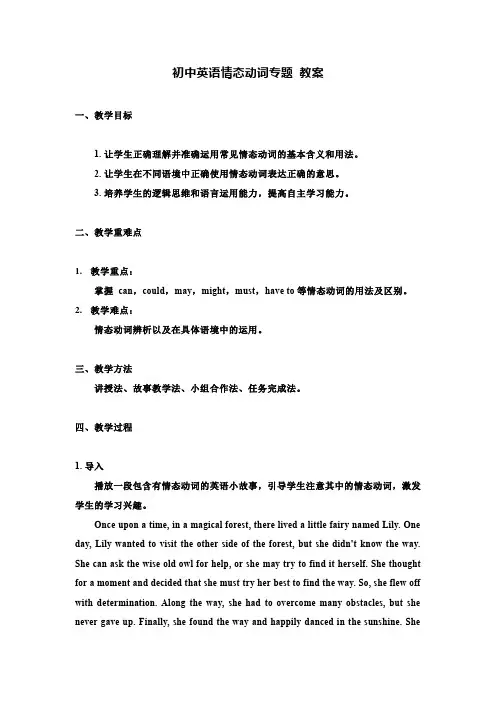
初中英语情态动词专题教案一、教学目标1.让学生正确理解并准确运用常见情态动词的基本含义和用法。
2.让学生在不同语境中正确使用情态动词表达正确的意思。
3.培养学生的逻辑思维和语言运用能力,提高自主学习能力。
二、教学重难点1.教学重点:掌握can,could,may,might,must,have to等情态动词的用法及区别。
2.教学难点:情态动词辨析以及在具体语境中的运用。
三、教学方法讲授法、故事教学法、小组合作法、任务完成法。
四、教学过程1.导入播放一段包含有情态动词的英语小故事,引导学生注意其中的情态动词,激发学生的学习兴趣。
Once upon a time, in a magical forest, there lived a little fairy named Lily. One day, Lily wanted to visit the other side of the forest, but she didn't know the way. She can ask the wise old owl for help, or she may try to find it herself. She thought for a moment and decided that she must try her best to find the way. So, she flew off with determination. Along the way, she had to overcome many obstacles, but she never gave up. Finally, she found the way and happily danced in the sunshine. Sheknew that she could do anything if she put her mind to it.2.知识讲解(1)具体讲解can,could,may,might,must,have to 等情态动词的含义和用法。
七年级英语情态动词教案一、选择题1.You ________ write the report again because spelling mistakes are not allowed at all. A.must B.can C.may D.could2.Think twice before making a decision, or you __________ get into trouble.A.may B.can't C.shouldn't D.mustn't3.You ________ require others to do with the problem like you. Everyone has his own way. A.mustn’t B.needn’t C.may not D.shouldn’t 4.—I must go to school today, ________?—No, you ________.You can go as soon as you get well.A.mustn’t I;needn’t B.needn’t I;needn’tC.mustn’t I;mustn’t D.needn’t I;mustn’t5.—How do you like my new dress?—Well, if I ________ say, it is not suitable for you.A.may B.must C.have to D.should 6.—Mum, why do I have to wear a mask before entering the supermarket?—For your health and safety, you ________ be too careful.A.shouldn’t B.can’t C.mustn’t D.needn’t 7.—The high school entrance examination is coming!— Yes, our teacher tells us we ________ be too careful while taking exams.A.mustn’t B.shouldn’t C.needn’t D.can’t8.We shouldn’t thr ow any objects from the building. Even a small object ________ cause serious injuries or death, when dropped from a great height.A.must B.should C.may D.need 9.—Could I join you in the programme?—Sorry, you ________. You are too young.A.shouldn’t B.must n’t C.can’t D.needn’t 10.Exercise is helpful but it ________ be regular (规律的) exercise.A.must B.may C.can D.need11.—Is it really necessary for me to go shopping with a mask on?—I’m afraid you ________ in public. It is not only to protect yourself but al so to protect others. A.must B.should C.can D.need12.A lot of online resources ________ be used either by teachers at school or parents at home. A.can B.should C.need D.must13.It’s amazing that the pen ________turn voice into text with few mistakes.A.can B.must C.may D.need 14.—Have you decided to take up teaching as career after graduation?—I ________ go abroad for further education instead. But it depends.A.must B.should C.may D.shall15.The boy is very brave.I ________ he ________ the tall tree.A.dare say; dares to climbB.dare to say; dare climbingC.dare saying; dares climbD.dare to say; dares climbed16.When I was young, my father ___________ take me to climb the hill which was not far from our house.A.may B.must C.would D.should17.You ______ pay too much attention to your pronunciation, as it is so important in the oral (口头的) test.A.shouldn’t B.mustn’t C.can’t D.needn’t 18.—Ready? Let’s get started, Martin.— Swimming? I just ________ get used to it in winter.A.can’t B.needn’t C.mustn’t D.s houldn’t 19.Dr. Zhong Nanshan once said, "To prevent the spread of this disease, we________never be too careful."A.can B.may C.must D.should 20.—Dad, must we wait until the light becomes green?—Yes, I am afraid we ________. That’s the traffic rule.A.may B.can C.have to D.need21.— The sandstorm in Beijing is so serious this year.— Yes, I wonder when we ________ worry about the air we breathe.A.can’t B.mustn’t C.needn’t D.shouldn’t 22.—In China, many parents complain that their children have to stay up late to do the homework.—Don’t worry. The government has realized the problem. I’m sure there ________ be good news soon.A.can B.should C.need D.must23.—Is it usually warm in Yancheng in May?—Yes. But it _______ be rather cold sometimes.A.must B.should C.would D.can24.You ________ pay too much attention to protecting yourself if you plan to go abroad. A.mustn’t B.can’t C.shouldn’t D.needn’t 25.When people are waiting at the zebra crossing, cars and buses ________ wait and let them go first.A.must B.may C.can D.need26.—Will dad arrive home at 6 o’clock to have dinner with us this evening?— I think he will, but he ________ not. Sometimes he works extra hours.A.can B.must C.need D.may27.—Must we stop the Japanese government discharging nuclear waste water (排放核污水) into the Pacific Ocean?—________. Because everyone should protect our earth and it is bad ________ us to eat thepolluted seafood and drink the waste water.A.Yes, we can; of B.No, we mustn’t; of C.Yes, we must; for D.No, we needn’t; for 28.Look at the floor, Tom! ________ you watch TV while having a meal?A.Should B.Could C.Must D.May29.To avoid ________, we’d better ________ the parents’ meeting online.A.gather; hold B.gathering; hold C.gather; holding D.to gather; to hold 30.Mr. Black ________ be at home now. He went abroad on vacation last Friday.A.can’t B.mustn’t C.needn’t D.shouldn’t 31.—Is that Mr Zhou?—It ________ be him. He has gone to Beijing.A.can B.may C.can’t D.shouldn’t 32.—The article says that a person’s animal sign de cides his personality.—You ________ read it for fun, but don’t believe in that.A.can B.must C.shouldn’t D.needn’t 33.—How beautiful the winter jasmines (迎春花) are!—Yes. These golden-yellow flowers ________ be widely seen in my city in March.A.must B.can C.would D.should 34.—May I have some wine to drink?—No, you ________. You have to drive home later.A.mustn’t B.needn’t C.can’t D.may not 35.—________ I see your ID card? We have to check your personal information.—Sure. Here you are.A.May B.Need C.Should D.Must36.—I think they are enough. We ________ make so many chairs.—I don’t think so. Because nearly a quarter of them need ________.A.don’t need to; mending B.needed; to be mendedC.don’t need; mend D.need; to mend37.We teenagers ________ have dreams. With dreams and hard work, anything amazing________ be created.A.may; can B.might; should C.should; can D.must; has to 38.It’s of great importance to protect the environment. Each of us ________ take an active part in it.A.can B.may C.would D.should 39.—Do we have to finish this today?—Yes, you ________ . Today is the last day.A.would B.may C.can D.must 40.Sometimes smiles ________ be false, hiding other feelings like anger, fear or worry. A.should B.would C.must D.can【参考答案】一、选择题1.A解析:A【详解】句意:你必须重新写报告,因为根本不允许有拼写错误。
情态动词教学案例 - 中考英语备考必备为了中考英语成绩更好,很多学生选择进行系统的备考。
而作为中考英语的一大重点——情态动词的掌握可谓是很重要的。
在这篇文章中,我们将会为大家展示一组情态动词教学案例,帮助他们更好地掌握情态动词的出现和用法。
一、教学目标1.掌握情态动词的本用法和出现方式。
2.学会如何在各种语言环境中正确运用情态动词。
二、教学内容1.了解情态动词的基本概念和用法。
情态动词是指在句子中表示说话人的态度、意见、推测、建议、请求、允许、必须等情感和意愿的词语,它们通常与动词原形连用,而且没有时态和人称的变化。
例如:can,could,may,might,shall,should,will,would等等。
2.掌握情态动词在不同语境下的具体使用。
情态动词在不同语境中使用有明确的规则,以下是一些常见的情态动词的用法和出现方式:1)can/could表示能力或允许。
例如:I can swim. 我会游泳。
2)may/might表示可能性或问询请求。
例如:May I help you? 我能帮助你吗?3)must表示强烈的义务、必须。
例如:We must study hard. 我们必须努力学习。
4)should表示议论、建议、责任等。
例如:You should go to bed early. 你应该早点睡觉。
5)will/would表示意愿、约定、习惯等。
例如:I will go to the park tomorrow. 明天我会去公园。
三、教学过程1.情景教学教师可以根据不同的情景设计一些教学活动,来协助学生更好地掌握情态动词。
例如:在购物的情境中,老师可以设计问答环节:A: Can I help you?B: Yes, I want to buy some apples.A: How many do you want?B: I want to buy five.2.语境教学情态动词的运用需要考虑到具体的语境,为此,教师可以设计图片、短话、文章,让学生感性认识到情态动词在不同语境中的典型用法,比如:图片教学教师可以准备一些反映具体情感和意愿的图片,让学生通过形象的图像来理解情态动词在不同语境中的具体运用,比如:短话教学教师可以给学生一些简短的话,让他们理解情态动词在不同语境中的意义和基本用法,例如:1)Can you help me lift the box?2)We should protect the environment.3)He will finish his homework before ten o'clock.文章阅读教师可以让学生阅读一些文章,让他们更全面地了解情态动词在不同语境中的使用情况,例如:四、教学方法1.语境优先情态动词在语境中的意义更加明确,因此,我们应该优先学习语境。
初中英语情态动词教案【篇一:情态动词教案】龙文教育教师1对1个性化教案教导处签字:日期:年月日一、教学衔接(课前环节)1、上次课后练习题讲解2、捕捉学生的思想动态和了解学生学习内容二、教学内容一、什么是情态动词?情态动词有具体的词义,但也同助动词一样,需要与其他词语一起构成句子的谓语,另外情态动词没有人称和数的变化,情态动词后必须跟动词原形。
情态动词主要有:can (could), may (might), must, shall (should), will (would), , need(needed),had better等。
情态动词无人称和数的变化(need特殊,可用作实意动词);不能单独使用,必须与其后的动词原形构成谓语,即:情态动词+ 动词原形i can finish the task by myself.i know i must study hard.二、情态动词句的否定式:在情态动词后加not【例题】变否定式:i will go to the museum tomorrow.三、变成一般疑问句时把情态动词提到句首。
【例题】变一般疑问句:i will go to the museum tomorrow.各情态动词的回答用语各有不同,需要特别注意。
(后面讲)四:情态动词的主要用法如下:can 的用法: 1. 表示能力(体力、知识、技能等),意为“能会”。
can you lift this heavy box?(体力)mary can speak three languages.(知识)此时can’t的意思是“不能”【例题】翻译:我不能帮你做作业。
你必须自己完成它。
2. 表示请求和允许,意为“可以”,此时可与may互换,回答语用yes, you can. 或 no, you can?t.【例题】翻译:——我现在可以走吗?——是的,你可以(走了)/ 不行,你不能 (走)。
could的用法:1. can的过去式,意为“能、会”,表示过去的能力。
初中英语教师资格证面试逐字稿一一口语教学教学类型:①语音教学②语法教学③阅读教学④听力教学⑤写作教学⑥口语教学英语教学设讣的基本步骤:一、教学内容二、教学目标与要求三、教学重、难点分析四、课前准备五、教学过程(3P模式)1、Wann-up/ Lead- In 复习 /导入2、PreSentatIOn 呈现3、PraCtiCe 练习4、PrOdUCtiOn巩固练习5、SuimnaiA r and HOmeW r ork 总结&作业六、BlaCkbOard DeSIgn 板书设汁Tips:而试时一泄要写板书口语教学Tips:授课思路:PwP模式1 ・ Warming-up/ Lead in:2.Pre-WTitillg3.WhileYvriting4.POSt-XVTitUlg5.SUmmary and homework1 •题目:口语试讲2.内容:A: ∖Xτhat are you going to be When you grow up ? B: Γ m going to be a Iq)Orter.A: How are you going to do that?B: Γm going to Wnte arucles and Send them to magazines and newspapers. A: W T here are you going to ∖voιk?B: Γ mnot SUre yet. Maybe BelJmg or Shanghai.3.要求:(1)全英文授课:(2)针对木材料内容.设汁相应的口语教学活动:(3)配合适当板书设计:(4)体现师生互动。
L ∖λarming-up/ Lead in:” GOOd morning ever}r one, nice to See you again, how are you? Great? SO glad to hear that, so, are you Ieady for today s lesson? Ok. CIaSS begins! Befbre We Start Our new, lesson, Iet me ask you a question. W r hat do you want to be In the fiιture? Oh I heard LIly says, a doctor Great! HOW about Bob? Yeah a teacher, just Ilke me, right? Good. 0ħ TUla WantS to be a scientist. Wonderful! SO you ne ed to StUdy hard to achieve your goal. NOW IetS OPen the book. Here are two StUdentS who're talking about their fiιnιre IdealJobs.2.PreSentatiOnifc Please USten to the dialogue and tell me: What do they Wailt to be When they grow up? Ok let's start. TlmeS up! WhO'd Ilke to Share your idea? The girl In red. please, a Iq)Orter. DO you agree with her? Exactly? Let's give her a big hand! By the way, your PrOmmCIatIOlI is Pretty good. SIt down please. SeenIS IIke ever}r one has your o∖vn Ideal job. NOW boys and girls. PleaSe Iead the dialogue again. 3 minutes."All right guys, have you IIOtlCed t his? Yeah If OtherS ask you about your ftιture plans, you Can USe this SentenCe pattern, *1 am going to be a...' Likewise, If you Want to know OtherS IdealJob, you Can say, 'Wlut are you going to be m the future?' or ‘What are you going to be when you grow up?' For example. I am going to be a teacher. Wlm are you going to be?"3・ PraCtiCeNOW gιιys, I need you to hsten to the dialogue again. TllIS time PleaSe try to Iead after the tape. Here Γll ShOW you SOme ti ps for your listening: YOU IIeed to Pay more attenuon to the SentelICeS that COntam key words, SUCh as noun, VerbS and SO on. And try to follow the tape Clear? Now, WheII you listening, PleaSe mind the SentenCeS that COntam 4I am going to be a...'and *Are you going to...?>M ok. let's begin.分角色读Ok. everybody, I Can See all Of you read It Ver)r carefully, this lime, Can you read It TVith your elbow partner? Well. Iet' S have a IOle play. YOU Can ChOOSe any ChaIaCter you IikU and I Can give you 5 minutes to practice. After that. I will InVIte SOme VOhinteerS to give Perfonllance. Ok, StOP here, WhO want to be the first pair? Ok. TOm and Jerry Wah, I IIke your PrOmInCIation. thank you. Then, another pair, WhO Want to Challenge them? ok. ROSe and Jack, ver>r good .you two Set a good exaιιψle for us... anyone else?..…4.PrOdUCtiOIlLet's PIay a game. I Wiil hand OUt SOme CardS WhlCh written SOme WordS about dιfierent jobs. When I PIay a song, you need to USe all the key WordS to make SentenCeS as fast as you can. Aild PUt UP your hands UP as SOOn as you finish it. For example. If your Card COntaInS "engineer, physics. New York, Engħsh∖ YOU Can say: Γm going to be an engineer. I am going to Ieanl PhySiCS In colleg e, then Γm going to further my StUdy In NeW York. I am going to W r ork harder In EnglISh Iearning. Clear? The fastest One Wln be get a SeCret gift after class. Ready? Let's start!或者Ok, JUSt IIOW We Ieanled how to describe OUr IdeaIJobs. I believe you WIll Work hard to make progress, right? And I WIll also encourage you In the PrOCeSS Of ChaSmg your goals. BUt Iemembe匚A JOUnley Of a thousand nules begins Wlth SmgIe step. If you want to succeed, you have to IlIake a plan. SO What Can We do to IealIZe your dream0 I Ileed at IeaSt five steps. Yeah you Can Work In groups, you are groupL you are group 2, and you are group 3, and One Of the group members ShOUld Share with US In the front, ok? Let's start!...5・ SUmmarV and homework*All right let, S See What We have Ieanled m this class, who Can make a SUmmary for us? Yes. OUr monitor, you please. TOday We Ieanlt how to talk about OUr ftιnιre plan, future job, right? Thank you Slt dovm please. And you* Ve done a Ieally good job. Γ mso P rOUd Of you. And I hope you Can Work harder to achieve your goal. Ok? HOmewOrk for today. PleaSe interview your ParentS about then JObS and ∖vπte down SOme Information. NeXt class, you Can Share something ∖nth us, SUCh as the name Of their jobs, what they USUal ly do. how many years tħey*ve ∖λr orked.. .∖λr hatever. And We UTIl Share It next class.口语教学设讣(3P模式)1・ TeaChmg ObjeCtiVeS1)KnOWIedge ObJeCtIVeSnldentS will Iealn a new pattern: wħat are you going to be..2)AbIlIty ObJeCUVeSnIdentS Will be able talk about their ftιture freely.3)EmOtIonal ObjeCtlVeSnIdeIItS ShOUId IealIZe that they ShOUId work harder to achieve their dream.2・ TeaChmg key and (IiffiCUlt POilItS1 ) Key PoIntHeIP StlldentS master the new Paitern2 ) DIffiCUIt POintGUIde SnIdeiItS to talk about their ftiuire.3.TeaChmg and Iearning methods Task-basedIangUage teaching method; COOPeratlVe IeanlnIg method; IndIVIdUal Ieanling method.4・ TeaChmg PrOCedUreSSteP 1: Lead InTaIk about then fiιtιιrejob.SteP 2: PreSentaUonSnIdentS read the passage, and answer SOme questions. TeaCher explain the IIeW Pattern SteP 3: PraCtiCeSnIdeIItS Iead after tape ROle-PIaySteP 4: PrOdUCtIOnPIay a game to nuke SentenCeSteP 5: SummarySnIdentS Siunmarize. and teacher gives Some supplements.SteP 6: HOmeWOrkIntemeW their ParentS about their job.5.BIaCkbOard designI am going to be a....What are you going to be iιι the ftιtιιre/ When you grow up.口语教学PWP模式教学思路1.Warming-up/ Lead in:2.Pre-SPeaking3.W T hIle-SPeaking4.POSt-SPeakmg5.SUmmary and homework1.题目:A man SaVed himself2.内容:A man ∖∖r as SkUng in Ihe mountains by hιnιself. SUddenIy he had a bad fall and broke his skis. When he tried to Stand UP he found that his Ieg WaS broken and he couldn't WaIk- SO he SIId down the mountain On his bottom. When he got to the bottom Of the hill ħe SaW a house. He ShOUted for about five IlinlUteS before anyone heard. At last...3.基木要求:(1)朗读所给段落(2)配合所给内容适肖板书(3)针对该段落的内容,设计相应的口语活动•帮助学生补充完成故事结局(4)试讲时间:约10分钟L Warming-up/ Lead in:'β GOOd morning ever>r one, IlICe to See you again, how are you? Great? SO glad to hear that. so. are you Ieady for today's lesson? Ok, CIaSS begins! Today. I PIePare a Short VldeO for you. IetS enjoy together. Ok, finish here, the VIeW is beautiful, right? Can you guess Where IS it? SO clever, I heard SOmeOne SaId Harbin, there IS snow, ice, how SPlendld right? HaVe you ever been to Harbin? No? Well, try it If you have achance, ok? It InUSt be VerJ r IntereStmg. Today, ΓU tell you a StorJ r- and this S(Ory happened Ul ∖λr inter. and It IS IeIated to snow, do you Want to know? Let me tell you, please. IISten to me CareftIlly.2.Pre-SPeakingOkay, that* S it. Then, WhO Can tell me why COUldlf t this man walk? Well, let, S answer together. HIS Ieg WaS broken, correct! Then ∖λr hat did he do? Yes, you please? Right, he SlId down the mountain to the bottom Of the hill and found a house. DO you agree Wlth her? Exactly! I agree With you. It ∖λ,as Very dangerous right?XMIat Wln happen next? Oh. We Can See this Story r ISn l t complete, right? Now, ImagnIe you are Ihe author Of this passage, what U r lH happen do you tħmk? Wd1、you Can talk WIth your desk mate. I Can give you 5 minutes.3.While-SPeakingOk, time's up, you are so involved. I guess dιfierent PeOPle have different ideas, right? YOU Can ∖vπt亡down SOme key words on your note books. I Can give you another 3 minutes, and after that. I WIn InVlte SOme StUdentS to Share IheIr IdeaS.0k. WiIO Want to be thefirst one? NanCy you please? YOur PrOlmnClatIOn is perfect. SO is your story, the man ∖∖r as SaVed In the end. I Ilke this endmg. Slt down、please. AnyOne else? Any different idea? Yes, Tommy, you please, wo. SO SCary your endmg is. but It IS Very interesting, excellent, Slt down、PleaSe..…4.POSt-SPeakiIlgJUSt IloW We Shared many IntereSting endings, and you are SO imaginative, Γm happy for you. JUSt Ilke the man did, Γm StrOngIy against that you do SUCh kind Of activity alone. it's too dangerous. DO you agree with me? Perfect. But, we all know. In Some place. SOme PeOPle Prefer dangerous activity, We Call It EXtreme Sports. IIke Climbing mountain WhICh IS Very high and WlthOUt any Safety measures.DO you agree WIth this kind Of action? No? Yes? Really. Why. Well-1 See two OPPOSIte ideas. HOW about let's have a debate. IfyOU SUPPort this action, you Can Stand On the Ieft side, IfnOt. the right side. Ok? LetS move quickly.Ok, SO you are the PrOS side, and you are the COnS side. Now, I Cail give you 10 minutes, you Can talk among your group.Ok. StOP here. Lets Start with the PrOS side, who's your representative? Yes5 MOmCa, you please, ok. In your opinion, PeOPle WhO PIay extreme SPOrtS IS exρeπencmg a COmPIetely dιflerent kind Of life. Also, this activity needs huge courage, WhiCh is Very SPeCl al among most Of people. WeIL Inake sense.And how about you. ConS side, Who is your SPe止"Yes, Kim. you please, eħ, yes, it*s too dangerous, and will IeSUIt In bad InflUelICe among teenagers. AlSO make sense. Guys, you are SO eloquent, Γm SO πnρressed. EYery CoIn has two sides, and you Can ContlnUe to talk about it after class.或者JUSt now, We Shared many IIItereStmg endings, and you are SO UnagmaUve. Γm happy for you. JUSt IIke the man did, Γm Strongly against that you do SUCh kind Of activity alone, it's too dangerous. And there are Inany kinds Of OUtdOor activities ∖λr e Can ChoOSe to have ftιn, right? W r hat kind Of OUtdOOr QCtlvIty do you IIke best? CIimbmg MOlIntam? I heard SomeOne SaId having picnic, WelL how about let's have a brainstorm. Can you name SOme kinds Of activities WhICh are not Only Safe but also interesting? WeIL I Can give you 10 mπιutes.OiC finished? YOU Can IalSe your hands, yes. Nina you please. PIaymg badnnnton. PIaying basketball, Pbymg football and SO on? Anythlng else? TIlaIIk you Slt do∖m please. AnyOne else? Yes, Judy, have a try. YeS having PlClιιc, I Ike BBQ, Very good, I IIke BBQ. too. AnyOne else? XVhO ∖λr ant to give Some SUPPleInent? Yes, VIllCent, please. Right. We Can dn∖vmg outdoors, for exaιιψle. PICk a beautiful ∖iew, and draw a PlCnire when the Weather IS fiιn, WOnderfilL It must be Ven r IntereStmg. Sit dovm please, guys, I hope you Can do those meanιngftιl things to enrich yoιιr SPare time.5・ SUmmary and homeworkI Can See here COmeS to the end Of OUr class. I hope all Of you make a Illtle progress. WhQt did We IeanI today? WhO'd Ilke make a SUmmary r for us? Yes, you please. V⅛y good. today we Ieanled an IntereSting story, and We ∖M0te an ending for it, right? V⅛y good, and you all InVe done a Ieally good job, Very creative. In the debate, We Shared Our idea, but no Inatter wħat. I hope you Wlll cħeπsh your life, and make It worthy. Ok?So, homework for today. PleaSe POlISh your ending. and try to tell the whole StOry to your parents, also, you ShOUId finish your exercise book. ok? Ok. CIaSS IS over, See you next time.口语教学设讣(PWP模式)1.TeaChing ObjeCtiVeS1) KnOwledge ObjeCtIVeSnIdeIltS will Iearn SOme basic elements to COntlnUe a Stor)r.2)Ablllty ObjeCUVeSnldentS will be able to COlItmUe the StOry m their o∖vn words.3)EmOtIOnal ObjeCtIVe StUdentS Wlll CherISh their life.2.TeaClling key and difficult POintSI)KeyPOmtHOW to help StUdentS ContlnUe the Sgry2) DIfiiCUlt POmtHoW to guide StUdentS to SlUlimanZe their Idea and express In their OulI words.3・ TeaChmg and Iearmng methodsTask-based IangUage teaching method: COOPeratIVe IeanIIng method; IndlVIdUal IearnlIlg method.4.TeaCIIing PrOCedUreSSteP 1: LeadmTeaCher will ShOw a video.SteP 2: Pre-SPeakingSnIdelItS read the PaSSage and IInderStalId it.SnldentS have a discussion about What WIll happen next.SteP 3: While-SPeakingSnIdentS ∖vπte down SOme key ∖voιds and Share their ending.SteP 4: POSt-SPeaklngSnIdeIItS do a debate about ∖^,hether We should Play extreme sport.SteP 5: HOmeworkSnIdeIltS need to IetelI their Ow p n Sgry to then ParentS and finish exercise.5.BlaCkbOar(I designHad a bad fall->broke his SkiS・> ____ ->slid down-> __________ShOUtedShoUId We SUPPoIt extreme sport?。
情态动词的基本用法教案一、教学目标1. 让学生掌握情态动词can, may, must, could, might, should 的基本用法。
2. 培养学生运用情态动词进行日常交流的能力。
3. 提高学生对英语语法和词汇的理解。
二、教学内容1. 情态动词can 的用法:表示能力、允许、请求、可能性等。
2. 情态动词may 的用法:表示请求、允许、可能性等。
3. 情态动词must 的用法:表示肯定、必须、推测等。
4. 情态动词could 的用法:表示过去的能力、请求、可能性等。
5. 情态动词might 的用法:表示可能性、请求、谦让等。
6. 情态动词should 的用法:表示应该、建议、可能性等。
三、教学重点与难点1. 重点:掌握情态动词can, may, must, could, might, should 的基本用法。
2. 难点:区分情态动词之间的用法和搭配,以及在不同语境中的运用。
四、教学方法1. 任务型教学法:通过小组讨论、角色扮演等任务,让学生在实际语境中运用情态动词。
2. 情境教学法:创设各种真实的情境,让学生在实践中学会使用情态动词。
3. 互动式教学法:引导学生积极参与课堂活动,提高课堂氛围,增强学生的学习兴趣。
五、教学步骤1. 导入:以一段对话引入情态动词的概念,激发学生的学习兴趣。
2. 讲解:分别讲解情态动词can, may, must, could, might, should 的基本用法。
3. 练习:设计不同情境的练习题,让学生运用所学情态动词进行回答。
4. 小组讨论:让学生分组讨论情态动词在不同情境下的用法,分享学习心得。
5. 角色扮演:分组进行角色扮演,模拟真实场景,运用情态动词进行交流。
6. 总结:对本节课所学内容进行总结,强调情态动词的用法和搭配。
7. 作业:布置相关练习题,巩固所学知识。
六、教学评估1. 课堂练习:观察学生在练习中的表现,了解他们对于情态动词用法的掌握情况。
初三中考英语语法专题复习之情态动词讲义教案1 学员编号:年级:初三课时数:学员姓名:辅导科目:英语学科教师:授课类型C 情态动词星级★★★ 教学目标1、掌握情态动词can / could 、may,might 、need 等的用法;2、掌握情态动词must, may, might, can, could 等表示“推测”的用法。
(建议2-5分钟)批注:通过以上图片中出现的情况,请学生一次性说出以上这些情态动词各自所表达的含义,由此使学生对本课产生C 专题-情态动词You can ’t kiss me,you are a dog.They mustbefriends. They may be afamily.He needs go tosleep.This guy should eatless, he is so big.兴趣。
(建议20-25分钟)一、情态动词的类型1. 只作情态动词的有:must; can(could); may(might);2. 可作情态动词也可作实义动词的有:need;3.可作情态动词也可作助动词的有:will(would); shall(should);4. 具有情态动词的某些特征的有:have to; ought to.批注:关于对情态动词类型的分析,只能针对基础较好的学生,基础差的学生一般很难理解上述的总结:关于第三点的解释—will 和shall作助动词可以用于将来时的构成中,shall一般只用于主语是第一人称的时候,would 和should则为过去将来时的构成;关于第四点的解释—have to 是有时态和三单形式的变化的,ought to 在变疑问句和否定句时,to 是被排除在外不作考虑的。
二、情态动词的特征1. 有一定的词义,但不能单独作谓语,必须和行为动词或系动词连用,构成谓语。
2. 无人称和数的变化(have to例外,用于第三人称单数时用has to).例:We must stay here.我们必须待在这儿。
十一、
1.题目:语法教学试讲
2.内容
Traditional Chinese doctor believe we need a balance of yin and yang to be healthy. For example, are you quiet and often tired? You may have too much yin.You should eat hot yang foods like beef, Dangshen and Huangqi herbs. But people who are too stressed out and angry may have too much yang. Chinese doctors believe that they should eat more yin foods like tofu.
3.基本要求:
(1)朗读所给段落;
(2)配合教学内容适当板书;
(3)针对划线部分的情态动词,设计相应的语法运用教学活动;
(4)用英文试讲;
(5)试讲时间10分钟。
教案:
语法教学试讲
1. Teaching aims
1) Knowledge aim
Students can understand the main idea of this passage and master modal verb.
2) Ability aim
Students can use the modal verb freely in speaking and reading. 3) Emotional aim
Cooperative spirit will be enhanced.
2. Important and difficult points
1) Important point
Help students to understand the modal verb, should and may.
2) Difficult point
Guide students to use the grammar point to describe things in daily life.
3. Teaching and learning methods
Task-based teaching method;Situational teaching method; Communicative teaching method; Cooperation learning method; Independent learning method.
4. Teaching procedures
Step 1: Lead in
Teacher will draw a pictures of Taiji and have a free talk with students-Do you know Taiji?
Step 2: Presentation
1) Read and answer. Students will read the passage and try to answer the questions--Q1: What is the main idea of this passage? Q2: If the people
who are too stressed out and angry, what should they do?
2) Conclude the grammar. Students will be guided to conclude the similar grammar structure-should ,may.......and share their ideas in groups. Then teacher will introduce the modal verb: may, should. And also, the negative forms-may not/should not…
Step 3: Practice
1) Translation game. Students will work in pairs and translate the sentences with each other by using the new grammar point.
2) Fill in the blanks with may and should.
Step 4: Production
1)Group discussion and design. Students will talk about the balance of yin and yang, and show their opinions.
2)Make a report by using the new grammar structure. Some students will be invited to show their reports to the whole class.
Step 5: Summary and homework
1) Some students will be guided to summarize what they have learned in this class.
2) Search more information about yin and yang on the internet. Then write a short passage about it.
5. Blackboard design
Yin: yang
Quiet angry
Tired stressed out
Toufu beef、dangshen、huangqi
You may have too much yin. You should eat hot yang food.
You may have too much yang. You should eat more yin food.。